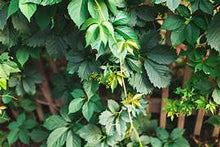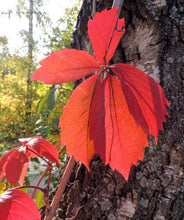Virginia Creeper (Parthenocissus quinquefolia) is a deciduous woody vine native to eastern North America. It is known for its striking foliage, which consists of five leaflets that resemble those of poison ivy. The leaves turn vibrant shades of red, orange, and purple in the fall, adding a beautiful splash of color to the landscape. The plant produces small green flowers in the spring, followed by dark blue berries that attract birds.
- Size: Virginia Creeper can grow vigorously, reaching heights of 30 to 50 feet (9 to 15 meters) or more if left unchecked. It spreads rapidly via its tendrils, which allow it to climb and adhere to surfaces such as walls, fences, and trees. When grown as a ground cover, it can also spread outward, covering large areas.
- Location: Plant Virginia Creeper in a location with well-draining soil and full to partial sunlight. It tolerates a wide range of soil types but prefers moist, fertile soil.
- Watering: Provide regular watering, especially during dry periods, to keep the soil consistently moist but not waterlogged.
- Pruning: Regular pruning is essential to control its growth and prevent it from becoming invasive. Prune in late winter or early spring before new growth begins to remove any dead or damaged branches and to shape the vine as desired.
- Support: Provide a sturdy support structure for the vine to climb, such as a trellis, fence, or arbor. Ensure that the support is strong enough to handle the weight of the mature plant.
- Fertilizing: Virginia Creeper generally doesn't require heavy fertilization. A balanced, slow-release fertilizer applied in spring can help promote healthy growth.
- Pest and Disease Control: This vine is relatively resistant to pests and diseases, but it may occasionally suffer from issues such as leaf spot or powdery mildew. Proper spacing, good air circulation, and avoiding overhead watering can help prevent these problems.
- Propagation: Virginia Creeper can be propagated from seeds or stem cuttings. Softwood cuttings taken in early summer or hardwood cuttings taken in late winter can both be successful. Allow seeds to stratify for several months before planting.




